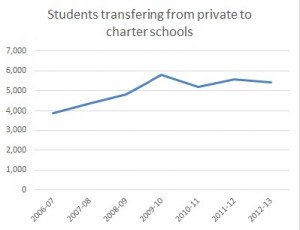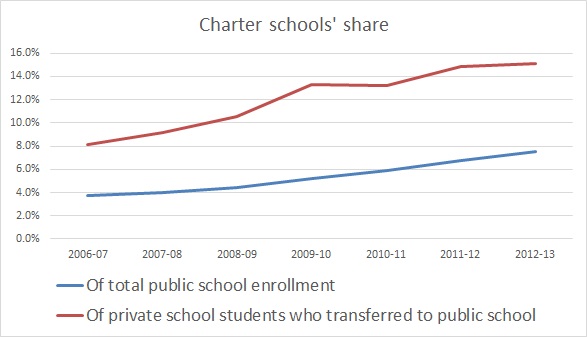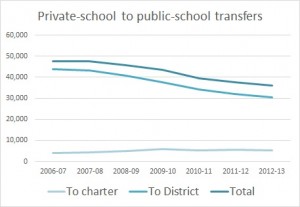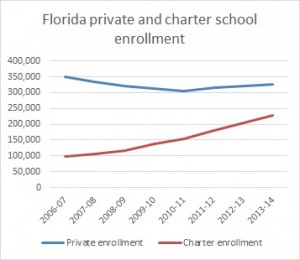Over the course of five years, more than 26,000 Florida students migrated from private schools to charter schools, according to state enrollment surveys.
That number comes from an analysis of seven years of student transfer data kept by the state Department of Education. It suggests that over time, the students who leave Florida’s private schools for public schools disproportionately favor charter schools — new alternatives that may share attributes with the schools they left behind.
At the same time, the number of students leaving private schools for public schools overall appears to be declining.
Together, these tends, which emerge from the data on students who transferred from private schools to public schools analyzed by redefinED, may help shed new light on the changing landscape of educational choice.

Just a few decades ago, the choice facing most parents was largely a binary one. Most would enroll their children at the local public school. Those who could afford tuition might send them to a private school.
The rapid, and still recent, rise of charter schools is changing that equation all over the country, presenting students with sought-after alternatives to their zoned public schools, and with tuition-free alternatives to private ones.
In Florida, the existence of some of the nation’s largest private school scholarship programs is changing the picture further still, by giving more families the means to afford private school tuition. Their own rapid growth appears to be shoring up total private school enrollment.
One such program, the Florida tax credit scholarship program, is administered by Step Up For Students, which co-hosts this blog and employs the author of this post.
The data on private-school-to-public-school-transfers are based on state enrollment surveys, which ask public schools to note where students were enrolled the previous school year. The numbers show:
- Students who leave private schools for public schools are disproportionately likely to enroll in a charter school, rather than a traditional public school. In 2012-13, the most recent year included, more than 15 percent of such transfers went to charter schools, which at the time enrolled less than 8 percent of Florida’s public-school students.
- As charter schools have grown, so has their relative share of students transferring from private schools.
- The total number of students leaving private schools for public schools each year has fallen by about a quarter since the 2006-07 school year. That decline is being fueled by a drop in the number of students transferring into district-run public schools.

The interplay between private schools and charter schools is starting to draw attention from school choice researchers.
Studies in New York and Michigan have found growing charter schools have drawn students away from private schools. A 2013 U.S. Census Bureau working paper posited: “If parents perceive charter schools as an improvement over regular public schools, then some households that previously enrolled their children in private schools will change from private to charter schools.”
Florida has seen this happen. In 2009, seven Catholic pastors in Miami-Dade led an effort to convert a collection of private Catholic schools at risk of shutting down into charters. That happened to be the year private-to-charter transfers peaked. At the time, the Great Recession was straining family budgets, as well as those of churches and other institutions that have historically helped underwrite private schools.

A report by Seton Education Partners found the charter conversions created a new way to offer students “a public school with a private school feel.” In addition to their previous private school students, the schools in question wound up attracting other, new students from the surrounding neighborhoods, many of them low-income.
The dynamic might seem uncomfortable for school choice advocates. Is one option drawing students away from another? A 2012 analysis by the Cato Institute warned about this issue in stark terms.
In the four most recent school years included in redefinED’s look at Florida data, the total number of private-to-charter transfer students hovered above 5,000 each year.
Yet as the recession has subsided and scholarship programs have grown, Florida’s private schools appear to be holding their own again. During the 2006-07 school year, more than 47,000 of their former students arrived in public schools. By 2012-13, that number had fallen below 36,000.

Enrollment figures from more recent years suggest it’s possible for private and charter school enrollment to grow in tandem.
Other recent studies support the idea that at least some parents are simply looking for options beyond their zoned public school, and are more concerned about factors like safety and a school’s perceived quality than its organizational structure — that is, whether it’s private, charter, or perhaps an attractive magnet program created by a school district.
If that’s the case, then scholarship programs that are bringing new populations of poor and working-class students into private schools may be having an impact on charter schools too. Would Florida’s nearly 70,000 low-income students using tax credit scholarships disproportionately attend charter schools if the scholarships weren’t available? Is competition among schools of choice more intense in some communities than in others?
The impact of the last recession on private school enrollment may also help make the case for extending scholarship eligibility to more working-class families, who might have kept their children in private schools if they could have afforded tuition. Otherwise, there may be a “hollowing out” of the private school population, in which the schools either cater to low-income students who qualify for scholarships or wealthy families who can afford tuition, leaving out families in the middle class.
These are issues we intend to wrestle with in future posts. In the meantime, take a look at the state-level data here.



[…] majority of charter school students come from traditional district schools, but data from Florida show that students leaving private schools are more likely to choose charters over other public […]